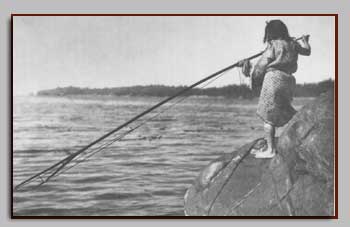Sealing
 Migrating fur seals feed in the deep water just off Umatilla Reef, three miles out from Ozette. This brings them closer inshore than anywhere else from California to Alaska. It gave Makahs the premier sealing station of the coast for, except in their rookeries, these animals don't come onto land.
Migrating fur seals feed in the deep water just off Umatilla Reef, three miles out from Ozette. This brings them closer inshore than anywhere else from California to Alaska. It gave Makahs the premier sealing station of the coast for, except in their rookeries, these animals don't come onto land.
In 25-foot canoes specially designed for speed and manned by two hunters, men paddled out to intercept the herds. They sought mostly females, which winter in temperate waters, then start north in early spring to give bird and breed anew. Today fur seals are a rare sight this far south; they were here formerly, however, for the bones are present in the early deposits at Ozette.
The males are huge, weighing up to 700 pounds. Females weigh only 75 to 100 pounds. Even so, sealers who loaded more than ten of them onto their canoe during a day's hunt had to gut them. Otherwise, that many seals would overload the canoe. Today's elders remember how it was to go sealing, and evidence from Ozette proves that the hunt is thousands of years old. All levels of the deposits hold more fur seal bones than those of any other kind of mammal.
Canoe paddles were silent: a long, pointed tip kept water from dripping noisily and hunters paddled without lifting the blades into the air. Unlike whaling harpoons, these shafts were lightweight so that they could be thrown accurately for 30 to 40 feet. A finger rest helped control aim. Two foreshafts held the barbed blades. One was longer than the other to improve chances for a hit. The Makah word for sealing harpoon means' "two points".
Fur seals sleep floating on their backs, with hind flippers curled onto their chests. Hunters watched for groups of three or four such sleepers, sometimes, slipping within 10 to 15 feet of them without disturbance. Larger groups had a sentinel likely to sound an alarm.
After a successful throw, a harpooner would draw in his seal by the cedar line attached to the twin mussel shell blades. Such lines might be as much as 12 fathoms long. As the enraged animals came alongside, someone bashed the head with a heavy club. Sometimes a frenzied seal leapt in the canoe. Sometimes it bit its captors. Even so, a successful hunt compensated well for the long paddles and the danger.
Villagers prized the oily blubber and rich fur which keep seals warm in cold northern waters. They also prized the lean, dark meat. Fur seals were seasonal, yet Makahs hunted them so successfully that they were fundamental to the year-round economy.
^ top

